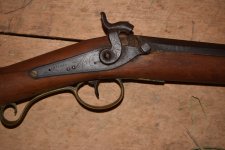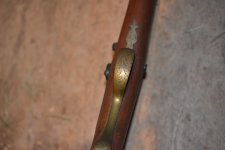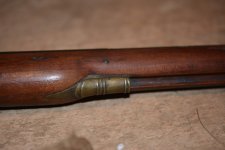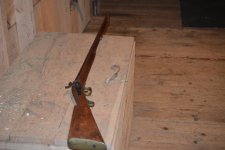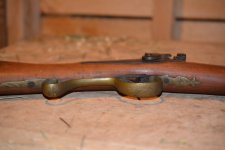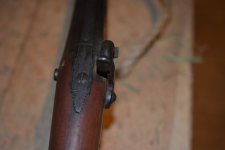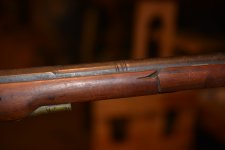Navigation
Install the app
How to install the app on iOS
Follow along with the video below to see how to install our site as a web app on your home screen.
Note: This feature may not be available in some browsers.
More options
You are using an out of date browser. It may not display this or other websites correctly.
You should upgrade or use an alternative browser.
You should upgrade or use an alternative browser.
✅ SOLVED .69 Caliber Musket Identification
- Thread starter coinman123
- Start date
BosnMate
Gold Member
- Sep 10, 2010
- 6,916
- 8,441
- Detector(s) used
- Whites MXT, Whites DFX, Whites 6000 Di Pro
- Primary Interest:
- Other
My guess is circa 1840, give or take 5 or 10 years either way, based on what I have heard from you guys and researched off of that information. How does that sound to you as an approximate manufacturing date? Thanks for all of the great info guys, going to try to make a display mount for the gun soon.
I think you are too early on your guess. The percussion cap wasn't invented until 1836. My guess would be in the neighborhood of the late 50's to the early 70's. However lots of muzzleloading firearms were being used in Appalachia until WWI, and even after. Now I'm going to have to do a little research.
Upvote
0
- May 9, 2012
- 23,988
- 81,483
- Primary Interest:
- Other
My guess is circa 1840, give or take 5 or 10 years either way, based on what I have heard from you guys and researched off of that information. How does that sound to you as an approximate manufacturing date? Thanks for all of the great info guys, going to try to make a display mount for the gun soon.
1800's is old enough. For now, till research reveals a tighter time frame.
Whenever it was built ,it was a versatile utilitarian piece, with conservative flair. The lock and the trigger guard were not plain Jane bare boned.
Some one prized it a while ,then who knows who else , and now you.
Upvote
0
BosnMate
Gold Member
- Sep 10, 2010
- 6,916
- 8,441
- Detector(s) used
- Whites MXT, Whites DFX, Whites 6000 Di Pro
- Primary Interest:
- Other
It appears that the back action patent came out about the same time as the invention of the percussion cap. But I still think it is a stretch to date your gun to the 30's or 40's. I will stick with my first guess, and say 50's to 70's. It's still a great, historical firearm, and you got a heck of a good deal.
Upvote
0
coinman123
Silver Member
- Thread starter
- #24
It appears that the back action patent came out about the same time as the invention of the percussion cap. But I still think it is a stretch to date your gun to the 30's or 40's. I will stick with my first guess, and say 50's to 70's. It's still a great, historical firearm, and you got a heck of a good deal.
Thanks! Maybe just wishful thinking with my date range, 50's to 70's is still just as cool. Someone could have easily taken a gun like this into the Civil War, who knows what the story is on mine. Like releventchair said, you can tell that someone truly prized this gun at one point. When I get the chance this week I will try to make a wooden display board to put it on to hang somewhere where everyone can see it. It's very cool to hold it in your hand and know that this was one of someone's most important possessions back in the day, to hunt for food, self defense, etc. Do you recommend that I get a light restoration from someone who knows what they are doing to fix up the wood and make a ramrod? Would it be worth it if I did this, or it best to leave it how it is. My only other gun was found by my grandfather while dredging in the Chesapeake bay, it is a Model 1858 Remington New Army the is now one big ball of rust after being in the ocean for probably one hundred fifty years. Maybe I could display it too.
Upvote
0
ecmjamsit
Hero Member
- Dec 2, 2007
- 873
- 1,062
- Detector(s) used
- Whites Goldmaster GMT, GMII,Whites Sierra Super Trac, Ace250, Teknetics Gamma 6000, Whites Pinpointer,Garrett Pro Pointer II
- Primary Interest:
- Metal Detecting
More clues!
"Seriously, I find two listings of "J. Bishop". One was a lock maker in Philadelphia c. 1790, which is too early if the cap lock is original. The other was a gun and lock maker in London, England, around 1840, which would be more in line with a date for a caplock. However, it looks to me like the lock was originally a flintlock as I can see holes that look like they were for the frizzen spring and screw, so the Philadelphia Bishop may be the right one. If so, he probably made and sold locks to local gunsmiths who used them on their own guns."
Excerpted from link below
https://thefiringline.com/forums/archive/index.php?t-63079.html
"Seriously, I find two listings of "J. Bishop". One was a lock maker in Philadelphia c. 1790, which is too early if the cap lock is original. The other was a gun and lock maker in London, England, around 1840, which would be more in line with a date for a caplock. However, it looks to me like the lock was originally a flintlock as I can see holes that look like they were for the frizzen spring and screw, so the Philadelphia Bishop may be the right one. If so, he probably made and sold locks to local gunsmiths who used them on their own guns."
Excerpted from link below
https://thefiringline.com/forums/archive/index.php?t-63079.html
Upvote
0
Kray Gelder
Gold Member
- Feb 24, 2017
- 7,005
- 12,554
- Detector(s) used
- Fisher F75
- Primary Interest:
- Metal Detecting
That's a fine looking, used well old weapon. An excellent wall hanger. Make sure you show us the powder horn when you get one. Then the kit bag, old decoys, fowling attire. You opened up a can, Coinman, enjoy!
Upvote
0
NOLA_Ken
Gold Member
- Jan 4, 2011
- 5,214
- 4,179
- Detector(s) used
- several, mostly Garrett
- Primary Interest:
- All Treasure Hunting
Thanks! Maybe just wishful thinking with my date range, 50's to 70's is still just as cool. Someone could have easily taken a gun like this into the Civil War, who knows what the story is on mine. Like releventchair said, you can tell that someone truly prized this gun at one point. When I get the chance this week I will try to make a wooden display board to put it on to hang somewhere where everyone can see it. It's very cool to hold it in your hand and know that this was one of someone's most important possessions back in the day, to hunt for food, self defense, etc. Do you recommend that I get a light restoration from someone who knows what they are doing to fix up the wood and make a ramrod? Would it be worth it if I did this, or it best to leave it how it is. My only other gun was found by my grandfather while dredging in the Chesapeake bay, it is a Model 1858 Remington New Army the is now one big ball of rust after being in the ocean for probably one hundred fifty years. Maybe I could display it too.
I would seriously advise leaving the stock as is, and don't touch the finish of the metal at all. A light cleaning with a very soft cloth and gun oil is all I would do. I would suggest taking a bore brush, and a bore cleaner made for black powder and thoroughly clean the inside of the barrel. Get all the accumulated gunk and lint out, wipe it clean with gun patches and give it a coat of oil inside as well. The reason I always say to clean the bore is that dirt and lint that collect in there over time (especially if it spent a long time leaned up in a corner) will attract and hold moisture just from humidity in the air and cause pitting inside. Other than that leave it as is, every scratch and ding on it is part of it's story.
Edit... Finding or making a ramrod for it won't have any effect on value, but it will make the gun complete, and in my opinion better to look at. If you look around you should be able to track down period ram rod caps and make a new one out of dowel rod, which is what I would want to do, but if you can't find old ones, someplace like Track of the Wolf.com or Dixie Gun Works might have what you need
Last edited:
Upvote
0
Red James Cash
Banned
- Aug 20, 2009
- 12,824
- 7,899
- Detector(s) used
- Garret Master hunter Cx Plus
- Primary Interest:
- Other
To clean the inside of the barrel,just use what was used.Boiling water and soap.Oil well after its dry.If possible take the barrel out of the stock.If not possible get rubber tubing that will fit over the nipple.Submerge the other end of the tube in the soapy water.A tight fitting cleaning patch will draw the water in then flush it out as the cleaning rod goes up and down the barrel.Hopefully it isnt loaded or you have some work for yourself

Last edited:
Upvote
0
BosnMate
Gold Member
- Sep 10, 2010
- 6,916
- 8,441
- Detector(s) used
- Whites MXT, Whites DFX, Whites 6000 Di Pro
- Primary Interest:
- Other
Thanks! Maybe just wishful thinking with my date range, 50's to 70's is still just as cool. Someone could have easily taken a gun like this into the Civil War, who knows what the story is on mine. Like releventchair said, you can tell that someone truly prized this gun at one point. When I get the chance this week I will try to make a wooden display board to put it on to hang somewhere where everyone can see it. It's very cool to hold it in your hand and know that this was one of someone's most important possessions back in the day, to hunt for food, self defense, etc. Do you recommend that I get a light restoration from someone who knows what they are doing to fix up the wood and make a ramrod? Would it be worth it if I did this, or it best to leave it how it is. My only other gun was found by my grandfather while dredging in the Chesapeake bay, it is a Model 1858 Remington New Army the is now one big ball of rust after being in the ocean for probably one hundred fifty years. Maybe I could display it too.
I wouldn't do anything to the gun, except use some lite oil --- 3 in 1 oil --- on the metal parts. If you remove the lock to oil the inside, use a proper fitting screw driver and don't screw up the screw heads any more than they probably are. Do NOT shine the brass or do anything to the metal other than a lite coat of oil. On the wood, you could hand rub a little linseed oil, not a lot, you are just protecting the wood, not baptizing it. Anything else you do to the gun takes away value. If you are not going to shoot it, why restore it? Anything you do from now on will take away value of the gun. On old guns, patina is everything, and if you take that away, you really can't get it back. As far as displaying it, here is what I did with mine. It's an original Pennsylvania long rifle. Pouch and powder horn are repo's.

As far as a ramrod goes, I'd probably get one. Google Track of the Wolf, and you can buy the wood and tip from them. If you want to be like an original and go all the way into the stock, then you probably will have to taper it some to get it to fit. What I do is chuck the dowel in a drill, and use sandpaper and taper the end that goes into the stock. The tip will have to be inlet so the brass end will fit, and then that is drilled and a small metal pin holds it in place. If you decide to make a ramrod, PM me and I'll help you out. Check with Track of the Wolf, or Dixie Gun Works, they might sell them already made up.
Have you checked to see if it's loaded? If not, take a dowel and on the outside of the barrel, lay it so that it goes all the way to the breech. Mark the dowel at the muzzle. Then insert it in the barrel, and if it doesn't go all the way to the breech, you probably have a loaded gun. Not dangerous, don't get excited. If it is loaded, you will need a worm to remove the load. You would be surprised how many old guns turn up loaded. Also, unless you know for sure it isn't loaded, DO NOT put a cap on the nipple and pop it. That's about all the typing I'm up to right now.
Last edited:
Upvote
0
coinman123
Silver Member
- Thread starter
- #31
I wouldn't do anything to the gun, except use some lite oil --- 3 in 1 oil --- on the metal parts. If you remove the lock to oil the inside, use a proper fitting screw driver and don't screw up the screw heads any more than they probably are. Do NOT shine the brass or do anything to the metal other than a lite coat of oil. On the wood, you could hand rub a little linseed oil, not a lot, you are just protecting the wood, not baptizing it. Anything else you do to the gun takes away value. If you are not going to shoot it, why restore it? Anything you do from now on will take away value of the gun. On old guns, patina is everything, and if you take that away, you really can't get it back. As far as displaying it, here is what I did with mine. It's an original Pennsylvania long rifle. Pouch and powder horn are repo's.
View attachment 1533564
As far as a ramrod goes, I'd probably get one. Google Track of the Wolf, and you can buy the wood and tip from them. If you want to be like an original and go all the way into the stock, then you probably will have to taper it some to get it to fit. What I do is chuck the dowel in a drill, and use sandpaper and taper the end that goes into the stock. The tip will have to be inlet so the brass end will fit, and then that is drilled and a small metal pin holds it in place. If you decide to make a ramrod, PM me and I'll help you out. Check with Track of the Wolf, or Dixie Gun Works, they might sell them already made up.
Have you checked to see if it's loaded? If not, take a dowel and on the outside of the barrel, lay it so that it goes all the way to the breech. Mark the dowel at the muzzle. Then insert it in the barrel, and if it doesn't go all the way to the breech, you probably have a loaded gun. Not dangerous, don't get excited. If it is loaded, you will need a worm to remove the load. You would be surprised how many old guns turn up loaded. Also, unless you know for sure it isn't loaded, DO NOT put a cap on the nipple and pop it. That's about all the typing I'm up to right now.
Thanks for all the great info. When I get the chance I will check to see if it is loaded. It would make sense to have a loaded gun on hand back in those days, if someone threatening came into your house, you probably wouldn't want to have to take the time to load a muzzleloader. If it is loaded then it would be interesting to see what the rounds look like.
I guess you're right, probably best to leave it how it is. It looks fine right now for a gun of it's age, I will try to put some linseed oil on the wood though, as it looks pretty dry and dull, but beautiful after I rubbed it down with a slightly wet paper towel. The wood looked almost like it did before I did this though a few minutes later. The metal looks very nice right now actually, I guess I will leave it how it is.
Your gun is a beauty, I love the wood and brass on it. The pistol is also very nice, I really like those old cap/flint lock pistols, maybe when I have the money I will get one to display with it. I wish I had some Civil War artifacts to display with my gun, I guess that my dug musket balls and percussion caps will have to work for now. Thanks BosnMate!
Last edited:
Upvote
0
DCMatt
Gold Member
- Oct 12, 2006
- 10,435
- 13,691
- Detector(s) used
- Minelab Equinox 600, EX II, & Musketeer, White's Classic
- Primary Interest:
- Metal Detecting
These guys can likely give you more info. Some of the most knowledgeable (and accessible) antique gun guys on the planet:
https://www.tapatalk.com/groups/britishmilitariaforums/british-flint-and-percussion-arms-f4/
https://www.tapatalk.com/groups/britishmilitariaforums/british-flint-and-percussion-arms-f4/
Upvote
0
coinman123
Silver Member
- Thread starter
- #33
Upvote
0
coinman123
Silver Member
- Thread starter
- #35
Thanks! I posted a thread there!
https://www.tapatalk.com/groups/britishmilitariaforums/viewtopic.php?f=4&t=22696
https://www.tapatalk.com/groups/britishmilitariaforums/viewtopic.php?f=4&t=22696
Upvote
0
DCMatt
Gold Member
- Oct 12, 2006
- 10,435
- 13,691
- Detector(s) used
- Minelab Equinox 600, EX II, & Musketeer, White's Classic
- Primary Interest:
- Metal Detecting
I used this stuff:
Kramers Home Page - Antiques restoration, preservation product
to clean 150+ years of yak fat and grime off of my EIC musket. It's a little spendy but worked well.
Kramers Home Page - Antiques restoration, preservation product
to clean 150+ years of yak fat and grime off of my EIC musket. It's a little spendy but worked well.
Upvote
0
NOLA_Ken
Gold Member
- Jan 4, 2011
- 5,214
- 4,179
- Detector(s) used
- several, mostly Garrett
- Primary Interest:
- All Treasure Hunting
I used this stuff:
Kramers Home Page - Antiques restoration, preservation product
to clean 150+ years of yak fat and grime off of my EIC musket. It's a little spendy but worked well.
Did you get one of the IMA muskets from Nepal? I keep thinking about getting one as a winter project
Upvote
0
DCMatt
Gold Member
- Oct 12, 2006
- 10,435
- 13,691
- Detector(s) used
- Minelab Equinox 600, EX II, & Musketeer, White's Classic
- Primary Interest:
- Metal Detecting
Did you get one of the IMA muskets from Nepal? I keep thinking about getting one as a winter project
Yes! Fun and interesting restoration! I sometimes use it in my Civil War reenacting (although it is technically NOT correct). If anyone asks, I tell them it's a British P42 (which is correct, or could be). Nobody has ever seen one, so I rarely get questioned.
FYI... The British P42 design was based on the EIC musket. I have a P42 wall hanger was able to scavenge to the sear spring from it for my EIC.
Last edited:
Upvote
0
coinman123
Silver Member
- Thread starter
- #39
"Welcome Coinman. I'll give you a couple of thoughts about your Gun. First, Im not sure its British. The lock may be, but these were often re-used or purchased as separate pieces. It has a back action lock and a barrel that looks significantly older than the guns current configuration. It was converted from flint to percussion, likely in the 1840's, and has a barrel type percussion assembly which was screwed or braised into the drilled out original touch-hole. The gun is 'Hook Breach' which means that the barrel should lift out if you were to remove the pins that hold it to the stock. It is probably best described as a 'fowler' or all purpose hunting gun.
Best, johnny"
I am wondering if the lock on mine my have been replaced at some point, if I am understanding what Johnny is saying. J. Bishop only made locks, not guns based on the information you guys have given me and some old records I have seen on the internet.
Best, johnny"
I am wondering if the lock on mine my have been replaced at some point, if I am understanding what Johnny is saying. J. Bishop only made locks, not guns based on the information you guys have given me and some old records I have seen on the internet.
Last edited:
Upvote
0
NOLA_Ken
Gold Member
- Jan 4, 2011
- 5,214
- 4,179
- Detector(s) used
- several, mostly Garrett
- Primary Interest:
- All Treasure Hunting
I don't see anything about the lock, stock, or brass fittings that tells me those parts haven't always been together. I don't think anything on it has been replaced.
As to the barrel... It's entirely possible that when this gun was built the gunsmith reused an old barrel and built a modern (at the time) gun with it. Gun barrels were expensive, and it would just make good sense to reuse one that was still in good shape rather than to scrap it and buy a brand new one. It doesn't bother me at all to think the barrel started out on an older flintlock that someone wanted upgraded, that was a pretty common practice.
As to the barrel... It's entirely possible that when this gun was built the gunsmith reused an old barrel and built a modern (at the time) gun with it. Gun barrels were expensive, and it would just make good sense to reuse one that was still in good shape rather than to scrap it and buy a brand new one. It doesn't bother me at all to think the barrel started out on an older flintlock that someone wanted upgraded, that was a pretty common practice.
Upvote
0
Top Member Reactions
-
 3332
3332 -
 1907
1907 -
 1885
1885 -
 1141
1141 -
 1096
1096 -
 865
865 -
 861
861 -
 839
839 -
 831
831 -
 747
747 -
 725
725 -
 548
548 -
 536
536 -
 503
503 -
 428
428 -
 427
427 -
E
413
-
 393
393 -
 392
392 -
 391
391
Users who are viewing this thread
Total: 2 (members: 0, guests: 2)
